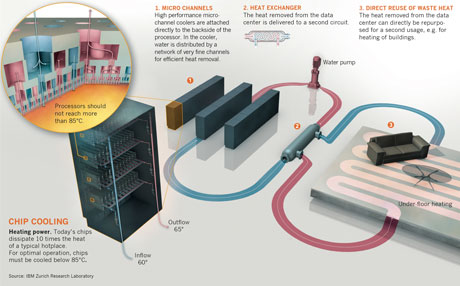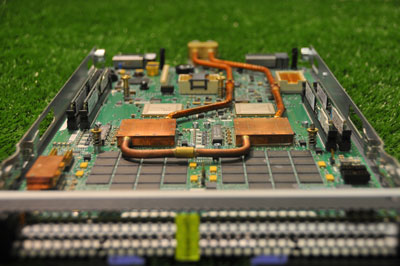by Gerhard Ingmar Meijer, Thomas Brunschwiler, Stephan Paredes, and Bruno Michel
'Zero-emission' data centres require 40% less energy than existing data centres, and by using their waste heat for purposes such as space heating their effective carbon dioxide emissions can be reduced by 85%. Payback for heat and improvements in efficiency can cut energy costs by a factor of two, with a return on investment in under two years.
The IT industry accounts for 2% of global carbon emissions, as much as is released by air traffic. This figure doubled in the past five years, and the worldwide electricity consumption of data centres now equals the energy produced by fourteen large (1 GW) power plants. Large (cloud) data centres consume up to 200 MW of electrical power, with all the excess heat produced being dissipated into the environment. At the same time, our society still uses high-value primary energy sources, such as gas and oil, for space heating. Our research group has developed an innovative concept that brings together the heat producer and the heat consumer to make waste heat productive: an attractive prospect from both an economic and an ecological perspective.
Up to 50% percent of the energy consumption and carbon footprint of an air-cooled data centre is caused not by computing but by powering the cooling systems needed to keep the microelectronic components from overheating. As energy efficiency is arguably the primary challenge faced by humanity in the 21st century, we can no longer afford to design computer systems based solely on the criteria of computational performance. The new target must be high performance and low net power consumption (and, concomitantly, low net carbon footprint). This requires high-performance liquid cooling.
Water is an excellent coolant which is able to capture heat about 4,000 times more efficiently than air. If high-performance liquid coolers are used, water with temperatures up to about 60°C would keep the processors at operating temperatures well below the maximally allowed 85°C. This eliminates the need for today’s energy-hungry chillers in the data centre. Moreover, the high-grade heat at the output can be reused, for example, for space heating.

Figure 1: Schematic concept of the zero-emission data centre. Heat is collected from the individual microelectronic components and transferred via a heat exchanger to a district heating system to be used for space heating.
We have built a small-scale prototype system at IBM as a testbed for a new water-cooled supercomputer that will be delivered to the Swiss Federal Institute of Technology Zurich (ETH) later this year. With its innovative water-cooling system, the energy consumption of this new supercomputer is expected to be reduced by 40% and its carbon footprint by 85% compared to systems using today’s air-cooling technology. The low carbon footprint is possible because the excess heat will be used to heat the university buildings (Figure 1). (Note: elimination of the carbon emission caused by combustion processes for space heating can, according to rules defined in the Kyoto Protocol, be credited against the carbon emission of the data centre).
The water-cooled supercomputer will consist of 33 IBM BladeCenter® QS22 (6 DP TFlop/s) and 9 IBM BladeCenter® HS22 and will have an efficiency of more than 500 MFlop/s per Watt. The blades will be equipped with high-performance micro-channel liquid coolers, and can easily be connected to and disconnected from the system (see Figure 2). The fluid loops of the individual blades link to the larger network of the server rack, which in turn is connected to the main water transportation network. The cooling system is a closed circuit: The cooling water is heated by the microelectronic components and circulated through a passive heat exchanger. In the heat exchanger, the excess heat is removed and fed directly into the heating system of the ETH.

Figure 2: Prototype of water-cooled blade with two high-performance micro-channel liquid coolers that remove heat from the processors.
This project is a significant step towards energy-aware, emission-free computing and data centres. With this new supercomputer system, we intend to demonstrate that using high-performance computing to address challenges in science need not have an adverse effect on energy consumption and the environment.
IBM and BladeCenter are trademarks of International Business Machines Corporation in the United States, other countries, or both. Other company, product, or service names may be trademarks or service marks of others.
Links:
http://www-03.ibm.com/press/us/en/pressrelease/27816.wss
http://www.research.ibm.com/journal/ rd/533/brunschwiler.pdf
Please contact:
Gerhard Ingmar Meijer
IBM Research GmbH, Zurich Research Laboratory, Switzerland
E-mail:










